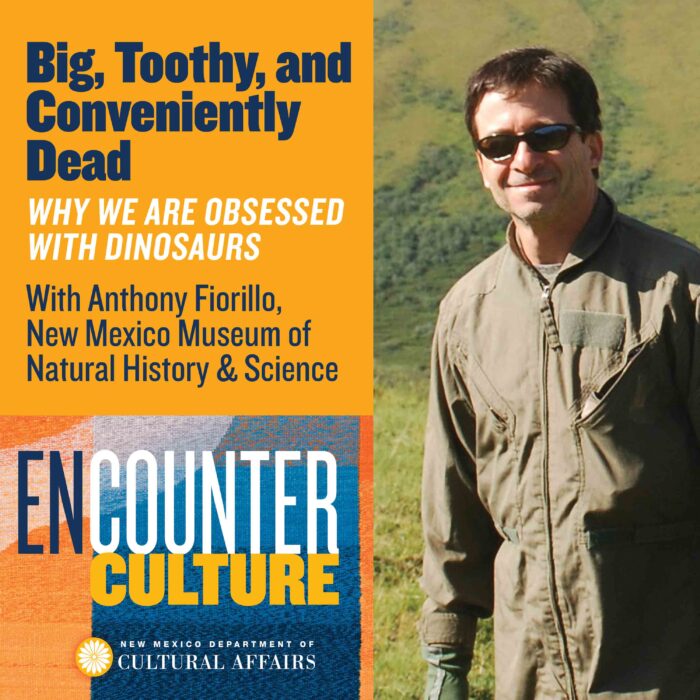If you’ve ever been to a Sinclair gas station and see the green dinosaur out front, paleontologist Tony Fiorillo says it’s a fair approximation of New Mexico’s Alamosaurus—which was first discovered in New Mexico more than one hundred years ago. Not only is the Alamosaurus a “New Mexican icon,” as Fiorillo says, but it’s also the only dinosaur discovered in North America so far that appears to have migrated from South America. Scientists believe the rest migrated south after crossing the Bering Land Bridge.
In addition to his work as a researcher and paleontologist, Dr. Tony Fiorillo is the executive director of the New Mexico Museum of Natural History & Science. Fiorillo received his PhD in geology from the University of Pennsylvania. His work at National Park Service sites earned him national recognition in 2000 and again in 2007 with the National Park Service, Alaska Region Natural Resource Research Award. In 2019, Fiorillo received the international George Wright Society’s Natural Resources Achievement Award. Additionally, Fiorillo has served as a Senior Fellow at the Institute for the Study of Earth and Man at Southern Methodist University since 2020, and has spent 20 years on the senior leadership team at Dallas’ Perot Museum of Natural and Science.
Traversing several continents, Dr. Fiorillo has studied dinosaurs and the environments in which they lived, and for more than two decades, he has focused on the Cretaceous of Alaska. His teams in Alaska have made significant advances in the understanding of ancient Arctic biodiversity and paleoecosystems as a way of understanding future climates.
In this episode, Fiorillo joins Encounter Culture host, Emily Withnall in a conversation about arctic dinosaurs, what 19th century scientists understood about the first dinosaurs they found, and how dinosaurs can provide insight for what’s in store for humans.
“One of the things that intrigued me and many of my colleagues, was the first dinosaur remains from the north were found not in Alaska, but they were found in Svalbard where there were these dinosaur footprints found in about 1960,” Fiorillo says. “That didn’t make any sense if you used the standard reptilian physiology model for dinosaurs. That was part of the fun, was challenging that stereotype with respect to the climate and now dialing into the Alaskan part of the story. Climate has a lot of variables.”
MENTIONED IN THIS EPISODE
New Mexico Museum of Natural History & Science
Benjamin Waterhouse Hawkins dinosaur sculptures at Crystal Palace
Dinosaurs at Denali National Park
We’d love to hear from you! Send feedback to elpalacio@dca.nm.gov. You can write a regular email or record a short voice memo and attach it for us to listen to.
Visit http://newmexicoculture.org for info about our museums, historic sites, virtual tours, and more.
Our favorite way to fully experience everything they have to offer is with the New Mexico Culture Pass. Find out how to get yours here.
Subscribe to El Palacio Magazine
Encounter Culture, a production of the New Mexico Department of Cultural Affairs, is produced and edited by Andrea Klunder at The Creative Impostor Studios.
Hosted by Emily Withnall, editor at El Palacio Magazine
Executive Producer: Daniel Zillmann
Technical Director & Post-Production Audio: Edwin R. Ruiz
Recording Engineer: Kabby at Kabby Sound Studios in Santa Fe
Editor & Production Manager: Alex Riegler
Theme Music: D’Santi NavaInstagram: @newmexicanculture


